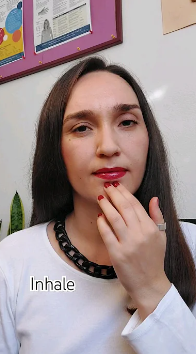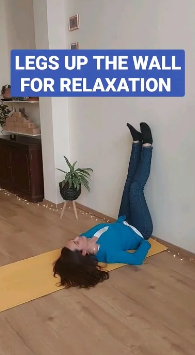
10 Ways to Deal With Stress
RESOURCE YOURSELF: Which of these 10 natural ways to deal with stress have you been practicing this past week? Is there one that you would like to set yourself as a health goal for this upcoming week/month?
1. Micromovements
2. Daily stretching
3. Reduce self-sabotage
4. Long exhales
5. Change your priorities
6. Eat healthier, drink healthier
7. Diaphragmatic breathing
8. Improve your sleep quality
9. Reduce your triggers
10. Journal every day
1. MICROMOVEMENTS
Breathing exercises, while they seem simple, can bring up uncomfortable sensations for people whose body is holding unresolved trauma.
Mindful micromovements are a possible alternative. One of my favourite micromovement exercises to do with clients who have a trauma history is to help them notice how when their posture has collapsed in a hunched position over their laptop, computer, or mobile phone, this closed body posture makes them feel worse.
Try it yourself. Sit hunched over for a minute or two. Notice how you feel. Then lift your spine up, starting from your waist. Notice – do you feel better, or worse? Alternate between hunching over and straightening your spine a bit to confirm which of the two feels more relaxing and which one makes you feel more stressed.
Next time you are aware that you are hunching over your phone or computer, you will know how to help yourself. You can thank me later. You are welcome 😉 🙂
2. Daily StretchinG
Long waiting periods can lead to an incremental build-up of mundane stress muscle tension during the day. For example, waiting for a long time in queue, whether it’s a physical queue at your local Post Office or waiting to be put through to customer service on the phone, can cause a build up of muscle tension. Especially if we’ve got a lot to do, and the wait feels frustrating.
Start by doing a quick body scan to see what part of your body is tensing up as you wait. If you notice your neck is tensing up, try a little 10 second neck stretch to help loosen it up. Another example is waiting in a long queue by the sidewalk and you are feeling our legs tensing up. Get creative and resourceful. Take a minute to just stretch out your legs one by one using the side walk.
Feeling a bit self-conscious about stretching in public (i.e. “What will people think if they see me stretching for a few seconds in public??”)? Challenge yourself to do a small stretch as a little experiment to see if anyone looks like they are judging you.
I find that people are so absorbed in their own worries and thoughts, it is very rare that anyone even notices! A liberating discovery. And the rare few who do notice don’t seem to care. People have other things on their mind that are more important than being bothered by someone who is just stretching in the queue. Really.
So instead of waiting for your next yoga class to stretch out all that build up of muscle tension, try building mini stretches into your daily “wait time” moments. It’s also quite a fun way to amuse yourself while you wait.
3. Reduce Self-Sabotage
Few articles on de-stressing talk about the link between self-sabotage and stress. Yet reducing self-sabotage plays a HUGE part in dealing with stress.
Let me give you an example. People pleasing is a self-sabotage pattern. When you are always focusing on pleasing others, you are bound to neglect your body’s needs and your well-being needs. It’s impossible to please everyone. The more intensely you feel the need to please others at whatever cost, the more likely you are to over-schedule your day and to over-give.
This can put a strain on your relationships as it can be stressful to be around someone who over-schedules their day because they are always anxious to get everything on their grueling to-do list. It is also a very stressful way to live.
Did you know that being very controlling is also a form of self-sabotage? Side note: to be clear, most of us don’t sit there consciously thinking of ways we can sabotage our own health, well-being, or personal/professional relationships. These habits and behavior patterns tend to operate on a subconscious level. Someone who is controlling may not even be aware that they are being controlling!
Other than the stress that someone who is behaving in a controlling way can cause others in their workplace or personal environment, it also causes high levels of stress for the controlling person’s physiology to be like that.
According to Positive Intelligence, a cutting edge branch of modern Psychology used with clients by coaches like myself, there are 10 ways in which we can sabotage our well-being and cause ourselves stress:
- Judge
- Avoider
- Controller
- Hyper-Achiever
- Hyper-Rational
- Hyper-Vigilant
- Pleaser
- Restless
- Stickler
- Victim
4. Long Exhales
Ever heard someone say “just take a few deep breaths – you will be fine” as stress management advice? It’s true that deep breaths help to calm the nervous system. However, if you are experiencing traumatic levels of stress, it can feel quite uncomfortable, and even triggering for some people, to try and take a deep breath.
A safer way to achieve the same result of taking a deep breath in, without the uncomfortable sensations that can sometimes come with trying to take a deep breath in, is to simply reverse the order. In other words, sigh.
Have a go! Start by taking a deep breath in, and then take a moment to notice how you feel. Follow it up with a nice big sigh, and then again notice how you feel. Did you notice that our belly expands after we sigh? It’s cool, isn’t it? Sighing is basically the equivalent of taking a deep breath in, but in reverse. It’s a more gentle way of taking a deep breath in.
Which of the two approaches feels better for you?
Another way that you can exhale for longer than you inhale is by inhaling for a count of 6 and exhaling for a count of 8. Once you get good at that, you can move on to inhaling for a count of 7 and exhaling for a count of 11 (also called the 7-11 Breathing technique).
Both of these types of breath work are trauma-informed and safe for people whose body is holding on to unresolved trauma.
5. Change YOUR PRIORITIES
Try this simple exercise. Make a list of your current priorities (1, 2, 3, etc), in your own words. It’s important to be honest about your ACTUAL priorities, not your desired priorities.
For example, you drink more alcohol in a week than you know is healthy, you don’t walk or exercise much, and you keep postponing booking medical appointments like dentists or dermatologists for months because you “don’t have time”? Then I think it’s fair to say that health is a low priority in your life right now.
Here’s another example. If you are working from morning to late at night, then your work/career is probably your top priority right now.
If despite working from morning to late at night you are making little money, then work may be a priority but making money may not be as high of a priority for you.
It can be very difficult to make an honest list of your current priorities because it may confront you with a truth that you may find difficult to accept. Sometimes what we think is a priority is actually a very low priority in our day to day life.
It may be because our conscious mind wants one thing, but subconsciously we may be stuck in self-sabotage patterns that make it hard for us to successfully implement our vision for our life priorities in practice.
4. DIAPHRAGMATIC BREATHING
Diaphragmatic breathing is also known as “belly breathing” because you direct the breath into your belly. This is a different kind of breathing to when you direct your breath to your chest.
You can tell the difference between these two types of breathing by placing one hand on your chest, and one on your stomach. Next, try to direct one inhale into your belly, and then next inhale into your chest. When you succeed, your chest/stomach will expand accordingly.
Do a little experiment. Compare how you feel when you take a couple of deep breaths in through your chest, versus how you feel after you take a couple of deep breaths into your belly. Notice how you feel after doing a few rounds of chest breathing, compared to how you feel after you do a few rounds of belly breathing. Which of the two feels more relaxing in your body?
Diaphragmatic breathing is good for de-stressing when you are feeling stressed and anxious, and chest breathing is good for getting energized when you are feeling stressed and a bit down or depressed.
7. EAT HEALTHIER, DRINK HEALTHIER
There Is more to reducing stress than just eating healthier. You may be eating very healthy food – organic vegetables and fruit, a balanced diet with plenty of healthy fats, protein, fresh fish, etc. AND be consuming an unhealthy amount of alcohol. Or coffee/sweet drinks with processed sugar.
Excessive or chronic consumption of alcohol or processed sugar in our drinks can cause inflammation. Inflammation is one of the main ways that chronic stress presents itself in the body. Reduce the intake of inflammatory substances by reducing your consumption to the healthy range, and the physiological stress you are putting your body through goes down.
Don’t know where to start? Try this mindful drinking meditation next time you feel a craving to drink to “destress”. Give yourself permission to drink, but keep tapping as you do so in order to stay mindful of what you are feeling and thinking as you drink.
8. IMPROVE YOUR SLEEP QUALITY
There are loads of natural ways that you can improve sleep quality without medication. We all have access to freely available resources for improving our quality of sleep. Here are two.
1. Start a daily medication practice using one of the countless meditations for sleep on YouTube. Here is one that is only 1 minute long. You can repeat it 8-10 time, or until you feel tired and peaceful this evening.
EFT MEditation for SLEEP & INSOMNIA
2. Another great way to help your nervous system wind down before bed is a yoga exercise called Legs up the Wall. It is a super simple way to stimulate the rest-and-digest parasympathetic nervous system state, which is good for sleep. Here’s how.
YOGA FOR SLEEP
9. REDUCE YOUR TRIGGERS
The word ‘triggering’ is often loosely used in everyday conversations to refer to something that triggers our stress response. The question is – if something has triggered your stress response, what are you gonna do about it?
One coping strategy is to avoid anything that causes you to feel stressed. Another way to deal with it is to work on severing the link between your stressors that trigger your stress response and your stress response. In other worse, you neutralize a trigger so that it stops triggering a stress response in your body.
Tapping meditations are a self-help way of working on reducing how triggered you feel by certain situations, in the moment. For example, do you find seeing your own reflection in the mirror triggers your stress response? If so, try the following tapping meditation to help neutralize how triggered you feel by what you see in the mirror.
Below you will find more tapping meditations like this one. Each one is tailored to a help you deal with a specific situation that may trigger your stress response.
Meanwhile, investing in therapeutic coaching with a trauma-informed EFT Practitioner is another great way of achieving a personal goal to reduce how triggered you feel by a specific situation.
The situation that you want to work on may be feeling triggered by: being on a plane (fear of flying), revising for an important test or exam, seeing something on the news, or even just thinking about going back to work on Monday morning and already feeling dread and stress on Sunday night.
For one person I worked with as their therapeutic coach, silence was triggering. So we agreed to worked on that together so that they could feel peaceful when they tuned into silence rather than feeling restless and triggered into ‘flight’ mode. For another person I worked with, fire was triggering. Again, we worked on neutralizing the trigger so that he could feel safe rather than being triggered and fearful at the site of fire.
Even emotions can trigger behaviours like emotional eating of processed food or drinking beer to ‘destress’, which then in turn increase our body’s stress response by increasing inflammation our body. Therapeutic coaching can help you learn how to drink and eat more mindfully by working on identifying the root of the problem – your loneliness, your sadness, etc.
10. JOURNAL EVERY DAY
There are many ways that you can journal in the morning or evening for stress management. Here are the types of journaling I’ve practiced the most over the last 30 years at different periods of my life:
- Gratitude Journaling (write down 3 things you are grateful once a day)
- Intention Journaling (writing the same word again and again for 5-20 minutes a day setting an intention of how you want to feel that day e.g. peaceful, creative, inspired, connected).
- Stream of Consciousness Journaling. Write write write write write – without thinking. If you want to rant, do so. If you want to unpack something that just happened, do so. No self-judgement. Be honest. Just write, get whatever is in your head and heart out and onto the page.
Have you tried journaling? If so, what type of journaling did you find most helpful?
MEET ELENI

Eleni Vardaki (BA, PGCE, QTS, MEd, Advanced EFT Practitioner) is an experienced educator and therapeutic coach who specializes in stress, anxiety, and academic success. She works with both school and university level students who want her assistance on clearing their inner blocks to achieving their personal, career-related, or academic goals. She leads online and on-site group sessions for psychotherapists, classroom teachers, and other allied professionals interested in learning new tapping skills.
EXAMPLES OF THERAPEUTIC COACHING







